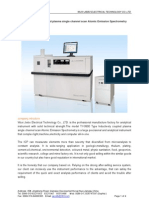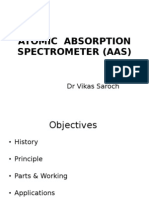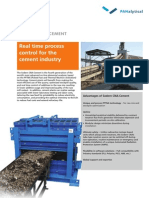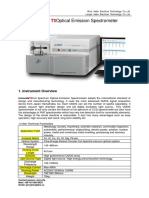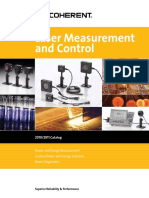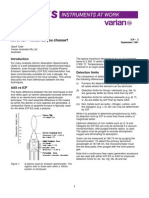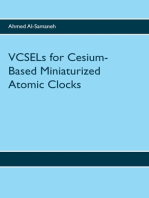44-74482BRO WorldLeaderAAICPMSICPMS
44-74482BRO WorldLeaderAAICPMSICPMS
Uploaded by
Oshin ParranganCopyright:
Available Formats
44-74482BRO WorldLeaderAAICPMSICPMS
44-74482BRO WorldLeaderAAICPMSICPMS
Uploaded by
Oshin ParranganOriginal Title
Copyright
Available Formats
Share this document
Did you find this document useful?
Is this content inappropriate?
Copyright:
Available Formats
44-74482BRO WorldLeaderAAICPMSICPMS
44-74482BRO WorldLeaderAAICPMSICPMS
Uploaded by
Oshin ParranganCopyright:
Available Formats
WORLD LEADER IN
AA, ICP-OES
AND ICP-MS
For a complete listing of our global offices, visit www.perkinelmer.com/ContactUs
Copyright 2008-2013, PerkinElmer, Inc. All rights reserved. PerkinElmer
is a registered trademark of PerkinElmer, Inc. All other trademarks are the property of their respective owners.
008044D_01
PerkinElmer, Inc.
940 Winter Street
Waltham, MA 02451 USA
P: (800) 762-4000 or
(+1) 203-925-4602
www.perkinelmer.com
PerkinElmer has been at the forefront of
inorganic analytical technology for over
50 years. With a comprehensive product
line that includes Flame AA systems,
high-performance Graphite Furnace AA
systems, flexible ICP-OES systems and the
most powerful ICP-MS systems, we can
provide the ideal solution no matter what
the specifics of your application.
We understand the unique and varied needs of the customers and markets we serve.
And we provide integrated solutions that streamline and simplify the entire process
from sample handling and analysis to the communication of test results.
With tens of thousands of installations worldwide, PerkinElmer systems are performing
inorganic analyses every hour of every day. Behind that extensive network of products
stands the industrys largest and most-responsive technical service and support staff.
Factory-trained and located in 150 countries, they have earned a reputation for consistently
delivering the highest levels of personalized, responsive service in the industry.
The Most Trusted
Name in Elemental
Analysis
Atomic Spectroscopy
A Guide to Selecting the
Appropriate Technique and System
F o r m o r e p r o d u c t i n f o r m a t i o n , v i s i t :
w w w . p e r k i n e l m e r . c o m / a t o m i c s p e c t r o s c o p y
Titan MPS Microwave Sample
Preparation System
Flexible, cost-effective solution for pressure
digestion of a broad range of samples
Connection-free and contact-free temperature/
pressure sensing for ultimate ease-of-use
Strong and durable digestion vessels are easy to
use and warrantied for one year
Autosamplers
Flexible rack configurations
Fast, accurate random access
Corrosion-resistant sampling components
Flow-through rinse station to minimize
sample-to-sample contamination
Mercury Hydride System
Highly sensitive determination of Mercury or
hydride-forming elements
FIAS
Fully automated flow-injection system
Simplifies and speeds up analyses requiring
complex sample preparation such as Mercury
and other hydride-forming elements
High-Throughput Sample-
Introduction System
Minimizes sample uptake and washout time
Throughput increased up to 2-3 fold
Eliminates sample contact with peristaltic pump
tubing
Graphite Furnace (for AAnalyst 400)
Quick, easy interchange between flame and
furnace
Low sample consumption (as low as a few L)
Exceptional detection limits, down to the pg range
Specialized Software
QC charting
Tools for 21 CFR Part 11 compliance
Speciation software
AA Consumables
HCL and EDL lamps
Graphite tubes
Standards
ICP-OES and ICP-MS Consumables
Cones
Torches
Nebulizers
Standards
ATOMIC SPECTROSCOPY
ACCESSORIES
For more information on any of the products shown here, or for a complete listing of all
atomic spectroscopy accessories available, please visit www.perkinelmer.com
Instrument Capability
PinAAcle/AAnalyst
Optima
NexION
TABLE OF CONTENTS
Atomic Spectroscopy - A Guide to Selecting the Appropriate Technique and System
What is Atomic Spectroscopy 3
Primary Industries 3
Commonly Used Atomic Spectroscopy Techniques 4
Flame Atomic Absorption Spectroscopy 4
Graphite Furnace Atomic Absorption Spectroscopy 5
Inductively Coupled Plasma Optical Emission Spectroscopy 6
Inductively Coupled Plasma Mass Spectrometry 7
Selecting a Technique For Your Analysis 8
Detection Limits 8
Analytical Working Range 9
Sample Throughput 9
Costs 9
Selecting a System For Your Analysis 10
AAnalyst 200/400 Atomic Absorption Spectrometers 11
PinAAcle 900 Atomic Absorption Spectrometers 11
Optima 8x00 ICP-OES Spectrometers 11
NexION 300 ICP-MS Spectrometers 12
Importance of Atomic Spectroscopy To Specific Markets 13
Atomic Spectroscopy Detection Limits 14
Atomic Spectroscopy Accessories 15
2
3
Atomic spectroscopy is the technique for
determining the elemental composition of an
analyte by its electromagnetic or mass spectrum.
Several analytical techniques are available, and
selecting the most appropriate one is the key to
achieving accurate, reliable, real-world results.
Proper selection requires a basic understanding of each technique since each
has its individual strengths and limitations. It also requires a clear understanding
of your laboratorys analytical requirements.
The following pages will give you a basic overview of the most commonly
used techniques and provide the information necessary to help you select the
one that best suits your specific needs and applications.
Primary Industries
Many industries require a variety of elemental determinations on a diverse
array of samples. Key markets include:
Environmental
Food
Pharmaceutical
Petrochemical
Chemical/Industrial
Geochemical/Mining
For more details, see Page 13.
WHAT IS ATOMIC
SPECTROSCOPY?
Biomonitoring
Agriculture
Semiconductor
Nuclear Energy
Renewable Energy
Nanomaterials
www.perkinelmer.com/atomicspectroscopy
There are three widely
accepted analytical methods
atomic absorption,
atomic emission and mass
spectrometry which will
form the focus of our
discussion, allowing us
to go into greater depth
on the most common
techniques in use today:
Flame Atomic Absorption Spectroscopy
Graphite Furnace Atomic Absorption Spectroscopy
Inductively Coupled Plasma Optical Emission Spectroscopy
(ICP-OES)
Inductively Coupled Plasma Mass Spectrometry (ICP-MS)
Flame Atomic Absorption Spectroscopy
Atomic Absorption (AA) occurs when a ground state atom
absorbs energy in the form of light of a specific wavelength
and is elevated to an excited state. The amount of light energy
absorbed at this wavelength will increase as the number of
atoms of the selected element in the light path increases.
The relationship between the amount of light absorbed and
the concentration of analytes present in known standards
can be used to determine unknown sample concentrations by
measuring the amount of light they absorb.
Performing atomic absorption spectroscopy requires a primary
light source, an atom source, a monochromator to isolate the
specific wavelength of light to be measured, a detector to
measure the light accurately, electronics to process the data
signal and a data display or reporting system to show the
results. (See Figure 1.) The light source normally used is a
hollow cathode lamp (HCL) or an electrodeless discharge
lamp (EDL). In general, a different lamp is used for each
element to be determined, although in some cases, a few ele-
HCL or EDL
Lamp
Flame Monochromator Detector
Figure 1. Simplified drawing of a Flame AA system.
4
ments may be combined in a multi-element lamp. In
the past, photomultiplier tubes have been used as the
detector. However, in most modern instruments, solid-state
detectors are now used. Flow Injection Mercury Systems (FIMS)
are specialized, easy-to-operate atomic absorption spectrometers
for the determination of mercury. These instruments use a
high-performance single-beam optical system with a low-pressure
mercury lamp and solar-blind detector for maximum performance.
Whatever the system, the atom source used must produce
free analyte atoms from the sample. The source of energy for
free-atom production is heat, most commonly in the form of
an air/acetylene or nitrous-oxide/acetylene flame. The sample is
introduced as an aerosol into the flame by the sample-
introduction system consisting of a nebulizer and spray
chamber. The burner head is aligned so that the light beam
passes through the flame, where the light is absorbed.
The major limitation of Flame AA is that the burner-nebulizer
system is a relatively inefficient sampling device. Only a small
fraction of the sample reaches the flame, and the atomized
sample passes quickly through the light path. An improved
sampling device would atomize the entire sample and retain
the atomized sample in the light path for an extended period
of time, enhancing the sensitivity of the technique. Which leads
us to the next option electrothermal vaporization using a
graphite furnace.
COMMONLY USED
ATOMIC
SPECTROSCOPY
TECHNIQUES
5
www.perkinelmer.com/atomicspectroscopy
Graphite Furnace Atomic Absorption Spectroscopy
With Graphite Furnace Atomic Absorption (GFAA), the sample
is introduced directly into a graphite tube, which is then heated
in a programmed series of steps to remove the solvent and
major matrix components and to atomize the remaining sample.
All of the analyte is atomized, and the atoms are retained
within the tube (and the light path, which passes through the
tube) for an extended period of time. As a result, sensitivity
and detection limits are significantly improved over Flame AA.
Graphite Furnace analysis times are longer than those for Flame
sampling, and fewer elements can be determined using GFAA.
However, the enhanced sensitivity of GFAA, and its ability to
analyze very small samples, significantly expands the capabilities
of atomic absorption.
GFAA allows the determination of over 40 elements in microliter
sample volumes with detection limits typically 100 to 1000
times better than those of Flame AA systems.
HCL or EDL
Lamp
Graphite
Tube
Monochromator Detector
Figure 2. Simplified drawing of a Graphite Furnace AA system.
The Periodic Table of the Elements
1
H
Hydrogen
1.00794
2
He
Helium
4.003
3
Li
Lithium
6.941
4
Be
Beryllium
9.012182
5
B
Boron
10.811
6
C
Carbon
12.0107
7
N
Nitrogen
14.00674
8
O
Oxygen
15.9994
9
F
Fluorine
18.9984032
10
Ne
Neon
20.1797
11
Na
Sodium
22.989770
12
Mg
Magnesium
24.3050
13
Al
Aluminum
26.981538
14
Si
Silicon
28.0855
15
P
Phosphorus
30.973761
16
S
Sulfur
32.066
17
Cl
Chlorine
35.4527
18
Ar
Argon
39.948
19
K
Potassium
39.0983
20
Ca
Calcium
40.078
21
Sc
Scandium
44.955910
22
Ti
Titanium
47.867
23
V
Vanadium
50.9415
24
Cr
Chromium
51.9961
25
Mn
Manganese
54.938049
26
Fe
Iron
55.845
27
Co
Cobalt
58.933200
28
Ni
Nickel
58.6934
29
Cu
Copper
63.546
30
Zn
Zinc
65.39
31
Ga
Gallium
69.723
32
Ge
Germanium
72.61
33
As
Arsenic
74.92160
34
Se
Selenium
78.96
35
Br
Bromine
79.904
36
Kr
Krypton
83.80
37
Rb
Rubidium
85.4678
38
Sr
Strontium
87.62
39
Y
Yttrium
88.90585
40
Zr
Zirconium
91.224
41
Nb
Niobium
92.90638
42
Mo
Molybdenum
95.94
43
Tc
Technetium
(98)
44
Ru
Ruthenium
101.07
45
Rh
Rhodium
102.90550
46
Pd
Palladium
106.42
47
Ag
Silver
107.8682
48
Cd
Cadmium
112.411
49
In
Indium
114.818
50
Sn
Tin
118.710
51
Sb
Antimony
121.760
52
Te
Tellurium
127.60
53
I
Iodine
126.90447
54
Xe
Xenon
131.29
55
Cs
Cesium
132.90545
56
Ba
Barium
137.327
57
La
Lanthanum
138.9055
72
Hf
Hafnium
178.49
73
Ta
Tantalum
180.9479
74
W
Tungsten
183.84
75
Re
Rhenium
186.207
76
Os
Osmium
190.23
77
Ir
Iridium
192.217
78
Pt
Platinum
195.078
79
Au
Gold
196.96655
80
Hg
Mercury
200.59
81
Tl
Thallium
204.3833
82
Pb
Lead
207.2
83
Bi
Bismuth
208.98038
84
Po
Polonium
(209)
85
At
Astatine
(210)
86
Rn
Radon
(222)
87
Fr
Francium
(223)
88
Ra
Radium
(226)
89
Ac
Actinium
(227)
104
Rf
Rutherfordium
(261)
105
Db
Dubnium
(262)
106
Sg
Seaborgium
(263)
107
Bh
Bohrium
(262)
108
Hs
Hassium
(265)
109
Mt
Meitnerium
(266)
110
(269)
111
(272)
58
Ce
Cerium
140.116
59
Pr
Praseodymium
140.90765
60
Nd
Neodymium
144.24
61
Pm
Promethium
(145)
62
Sm
Samarium
150.36
63
Eu
Europium
151.964
64
Gd
Gadolinium
157.25
65
Tb
Terbium
158.92534
66
Dy
Dysprosium
162.50
67
Ho
Holmium
164.93032
68
Er
Erbium
167.26
69
Tm
Thulium
168.93421
70
Yb
Ytterbium
173.04
71
Lu
Lutetium
174.967
90
Th
Thorium
232.0381
91
Pa
Protactinium
231.03588
92
U
Uranium
238.0289
93
Np
Neptunium
(237)
94
Pu
Plutonium
(244)
95
Am
Americium
(243)
96
Cm
Curium
(247)
97
Bk
Berkelium
(247)
98
Cf
Californium
(251)
99
Es
Einsteinium
(252)
100
Fm
Fermium
(257)
101
Md
Mendelevium
(258)
102
No
Nobelium
(259)
103
Lr
Lawrencium
(262)
1
H
Hydrogen
1.00794
Atomic number
Element Name
Atomic Mass
Element Symbol
Ds
Darmstadtium
Rg
Roentgenium
The Periodic Table of Elements See page 14 for a listing of detection limits for all elements using
the different atomic spectroscopy methods.
Inductively Coupled Plasma Optical Emission
Spectroscopy
ICP is an argon plasma maintained by the interaction of an RF
field and ionized argon gas. The plasma can reach temperatures
as high as 10,000 K, allowing the complete atomization of the
elements in a sample and minimizing potential chemical inter-
ferences.
Inductively Coupled Plasma Optical Emission Spectroscopy
(ICP-OES) is the measurement of the light emitted by the
elements in a sample introduced into an ICP source. The
measured emission intensities are then compared to the
intensities of standards of known concentration to obtain
the elemental concentrations in the unknown sample.
There are two ways of viewing the light emitted from an ICP.
In the classical ICP-OES configuration, the light across the
plasma is viewed radially (Figure 3a), resulting in the highest
upper linear ranges. By viewing the light emitted by the sample
looking down the center of the torch (Figure 3b) or axially, the
continuum background from the ICP itself is reduced and the
sample path is maximized. Axial viewing provides better detec-
tion limits than those obtained via radial viewing by as much
as a factor of 10. The most effective systems allow the plasma
to be viewed in either orientation in a single analysis, providing
the best detection capabilities and widest working ranges.
The optical system used for ICP-OES consists of a spectrometer
that is used to separate the individual wavelengths of light and
focus the desired wavelengths onto the detector (Figure 4).
Older, direct reader types of ICP-OES systems used a series of
photomultiplier tubes to determine pre-selected wavelengths.
This limited the number of elements that could be determined
as the wavelengths were generally fixed once the instrument
was manufactured. Sequential-type systems can select any wave-
length and focus it on a single detector. However, this is done
one element at a time, which can lead to longer analysis times.
In todays modern ICP-OES systems, solid-state detectors based
on charge-coupled devices (CCD) are used, providing very flexible
systems and eliminating the need for large numbers of single
photomultiplier detectors.
Plasma Spectrometer Detector
Figure 4. Simplified drawing of a basic ICP system.
Figure 3a. Radially viewed plasma with a vertical slit image in the plasma.
Figure 3b. Axially viewed plasma with an axial slit image in the plasma.
6
7
www.perkinelmer.com/atomicspectroscopy
Inductively Coupled Plasma Mass Spectrometry
With Inductively Coupled Plasma Mass Spectrometry (ICP-MS),
the argon ICP gener ates singly charged ions from the elemental
species within a sample that are directed into a mass spectrometer
and separated according to their mass-to-charge ratio. Ions
of the selected mass-to-charge ratio are then directed to a
detector that determines the number of ions present (Figure 5).
Typically, a quadrupole mass spectrometer is used for its ease-
of-use, robustness and speed. Due to the similarity of the
sample-introduction and data-handling techniques, using an
ICP-MS is very much like using an ICP-OES system.
ICP-MS combines the multi-element capabilities of ICP
techniques with exceptional detection limits equivalent to
or below those of GFAA. It is also one of the few analytical
techniques that allows the quantification of elemental
isotopic concentrations and ratios, as well as precise
speciation capabilities when used in conjunction with HPLC
or GC interfaces. This feature enables the analytical chemist
to determine the exact form of a species present not just
the total concentration.
Figure 5. Simplified drawing of ICP-MS system with Universal Cell Technology (UCT).
However, due to the fact that the sample components are actually
introduced into the instrument, there are some limitations as
to how much sample matrix can be introduced into the ICP-MS.
In addition, there are also increased maintenance requirements
as compared to ICP-OES systems. Generally, ICP-MS systems
require that the total dissolved solids content of a sample be
below 0.2% for routine operation and maximum stability. There are
several items, such as the interface cones and ion lens, located
between the ICP torch and the mass spectro meter, that need to
be cleaned on a periodic basis to maintain acceptable instrument
performance.
Recent developments have led to new technologies to increase
the robustness and stability of ICP-MS. Orthogonal ion lens
systems increase the ability of the ICP-MS to handle higher
total dissolved solids content and dramatically improve long-
term stability for high matrix solutions. Interference control has
been made even easier by using universal cell technologies that
include both collision (using Kinetic Energy Discrimination KED)
and Dynamic Reaction Cell (DRC) in a single instrument allowing
the analyst to choose the best technique for their samples.
Detector Quadrupole Mass Filter Universal Cell
Quadrupole Ion Deflector
Triple Cone
Interface
8
SELECTING A
TECHNIQUE FOR
YOUR ANALYSIS
With the availability
of a variety of
atomic spectroscopy
techniques, laboratory
managers must
decide which of these
is best suited to their
particular analytical
requirements. Unfortunately, because the techniques complement
each other so well, it may not always be clear which is the
optimum solution for a particular application.
Selecting a technique requires the consideration of a variety of
important criteria, including:
Detection limits
Analytical working range
Sample throughput
Data quality
Cost
Interferences
Ease-of-use
Availability of proven methodology
In order to help you narrow your selection, many of these criteria
are discussed below for Flame AA, Graphite Furnace AA, ICP-OES
and ICP-MS. In simple terms, your choice can be guided by
answering the four questions in Table 1.
Detection limits
The detection limits achievable for individual elements are
important in determining the usefulness of an analytical
technique for a given analytical problem. Without adequate
detection-limit capabilities, lengthy analyte concentration
procedures may be required prior to analysis.
Typical detection-limit ranges for the major atomic spectro-
scopy techniques are shown in Figure 6. For a complete listing
of detection limits by element for Flame AA, GFAA, ICP-OES
(with radial and axial torch configurations) and ICP-MS, see
the table on page 14.
100 10 1 0.1 0.01 0.001
Detection Limit Ranges (ppb or g/L)
Flame AA
ICP Emission Radial
ICP Emission Axial
Hydride Generation AA
GFAA
ICP-MS
Figure 6. Typical detection limit ranges for the major atomic spectroscopy
techniques.
Table 1. Technique decision matrix.
Flame AA GFAA ICP-OES ICP-MS
How Many Elements?
Single
Few
Many
What Levels?
High ppb
Sub ppb
Sub ppb-ppm
Sub ppt
How Many Samples?
Very few
Few
Many
How Much Sample?
> 5 mL
< 1-2 mL
9
Analytical working range
The analytical working range can be viewed as the concentration
range over which quantitative results can be obtained without
having to recalibrate the system. Selecting a technique with an
analytical working range (and detection limits) based on the
expected analyte concentrations minimizes analysis times by
allowing samples with varying analyte concentrations to be
analyzed together. A wide analytical working range can also
reduce sample-handling requirements, minimizing potential errors.
Sample throughput
Sample throughput is the number of samples that can be
analyzed or elements that can be determined per unit of time.
For most techniques, analyses performed at the limits of
detection or where the best precision is required will be more
time-consuming than less demanding analyses. Where these
factors are not limiting, the number of elements to be
determined per sample and the analytical technique will
determine the sample throughput.
Flame AA Provides relatively high sample throughput when
analyzing a large number of samples for a limited number of
elements. A typical determination of a single element requires
only 3-10 seconds. However, Flame AA requires specific
light sources and optical parameters for each element to be
determined and may require different flame gases for different
elements. As a result, even though it is frequently used for
multi-element analysis, Flame AA is generally considered to
be a single-element technique.
1 2 3 4 5 6 7 8 9 10
Orders of Magnitude of Signal Intensity
ICP-OES Dual View
ICP-MS
ICP-OES Radial View
ICP-OES Axial View
Flame AA
Hydride Generation AA
GFAA
Figure 7. Typical analytical working ranges for the major atomic spectroscopy
techniques.
$0K $50K $100K $150K $200K
Typical complete system cost ($US)
ICP-OES
ICP-MS
Flame AA
GFAA
Figure 8. Typical relative purchase prices for atomic spectroscopy systems.
Graphite Furnace AA As with Flame AA, GFAA is basically
a single-element technique. Because of the need to thermally
program the system to remove solvent and matrix components
prior to atomization, GFAA has a relatively low sample through-
put. A typical graphite-furnace determination normally requires
2-3 minutes per element for each sample.
ICP-OES A true multi-element technique with exceptional
sample throughput. ICP-OES systems typically can determine
more than 73 elements per minute in individual samples.
Where only a few elements are to be determined, however,
ICP is limited by the time required for equilibration of the
plasma with each new sample, typically about 15-30 seconds.
ICP-MS Also a true multi-element technique with the same
advantages and limitations of ICP-OES. ICP-MS can typically
determine more than 73 elements per minute in an individual
sample, depending on such factors as the concentration
levels and required precision. Although ICP-MS has a wide
working range, the upper linear concentration range is
generally less than that of ICP-OES systems and may require
that some samples be diluted.
Costs
As they are less complex systems, instrumentation for single-
element atomic spectroscopy (Flame AA and GFAA) is generally
less costly than that for the multi-element techniques (ICP-OES
and ICP-MS). There can also be a considerable variation in cost
among instrumentation for the same technique. Instruments offering
only basic features are generally less expensive than more versatile
systems, which frequently also offer a greater degree of automation.
Figure 8 provides a comparison of typical instrument price ranges
for the major atomic spectroscopy techniques.
10
SELECTING A
SYSTEM FOR
YOUR ANALYSIS
Flame AA Flame Atomic
Absorption Spectroscopy
GFAA Graphite Furnace
Atomic Absorption
Spectroscopy
ICP-OES Inductively
Coupled Plasma Optical
Emission Spectroscopy
ICP-MS Inductively
Coupled Plasma Mass
Spectrometry
Very easy-to-use
Widely accepted
Extensive application
information available
Relatively inexpensive
Exceptional detection limits
Well-documented
applications
May be left unatteneded
Best overall multi-element
atomic spectroscopy
technique
Excellent sample throughput
Very wide analytical range
Good documentation
available for applications
May be left unatteneded
Easy-to-use
Exceptional multi-element
capabilities
Ability to perform isotopic
analyses
Well-documented
interferences and
compensation methods
Rapidly growing application
information
Detection limits equal to
or better than GFAA with
much higher productivity
May be left unattended
Low sensitivity
Single-element analytical
capability
Cannot be left unattended
(flammable gas)
Limited analytical working
range
Sample throughput
somewhat less than other
techniques
Higher initial investment
Highest initial investment
Method development
more difficult than other
techniques
Limited solids in sample
Ideal for laboratories analyzing
large numbers of samples for
a limited number of elements
and for the determination of
major constituents and higher
concentration analytes.
Ideal for laboratories analyzing
a limited number of elements
and requiring excellent detec-
tion limits.
Ideal for laboratories analyzing
multiple elements in a moderate
or large number of samples.
Ideal for laboratories analyzing
multiple elements in a large
number of samples and
requiring a system capable
of determining trace and ultra-
trace analyte concentrations.
AAnalyst 200/400
AA Spectrometers
PinAAcle
AA Spectrometers
Optima ICP-OES
Spectrometers
NexION ICP-MS
Spectrometers
TECHNIQUE STRENGTHS LIMITATIONS APPLICATIONS SYSTEM
Once you have identified the best solution for your particular application, read on for more in-depth product details.
AAnalyst 200/400 Atomic Absorption Spectrometers
Whether you choose the AAnalyst
200 or AAnalyst 400, youll discover an easy, affordable
and reliable flame atomic absorption (AA) solution. Weve simplified the process of AA
analysis, from sample introduction to results. Weve made it easy for anyone with a basic
understanding of AA to get fast, reliable results every time, and weve made the quality
and reliability of PerkinElmer available to everyone with these affordable systems.
Easy to use, easy to own, and featuring many of the advances that have made PerkinElmer
the market leader, the AAnalyst 200 and 400 are the perfect choice for any laboratory
needing a reliable, trouble-free solution for flame AA analysis.
PinAAcle 900 Atomic Absorption Spectrometers
The PinAAcle
series of atomic absorption (AA) spectrometers brings AA performance to new
heights. Engineered with an array of exciting technological advances, it offers a variety of
configurations and capabilities to deliver exactly the level of performance you need:
Flame only, furnace only, or space-saving stacked designs featuring both
Flame, furnace, flow injection, FIAS-furnace and mercury/hydride capabilities on a single
instrument
Choice of Deuterium or longitudinal Zeeman background correction
TubeView
color furnace camera simplifies autosampler tip alignment and sample dispensing
Proven WinLab32
software offering both ease-of-use and exceptional flexibility
And no matter which model you select (900F, 900Z, 900H, 900T), youll discover an intuitive,
highly efficient system capable of simplifying your journey from sample to results even
with the most difficult matrices.
Optima 8x00 ICP-OES Spectrometers
With its groundbreaking features and expanded capabilities, the Optima
8x00 series is
more than just an evolution of the worlds most popular ICP-OES its a revolution. Built
around the proven design of the Optima platform, the 8x00 series delivers breakthrough
performance through a series of cutting-edge technologies that enhance plasma stability,
simplify method development and dramatically reduce operating costs:
Flat Plate
Plasma Technology with a patented, maintenance-free RF generator uses
half the argon of traditional systems dramatically reducing operating costs.
Patented Dual View offers radial and axial viewing of the plasma for effective measurement
of elements with high and low concentrations in the same method.
PlasmaCam
Viewing Camera offers continuous viewing of the plasma, simplifying method
development and enabling remote diagnostic capabilities for maximum uptime.
11
12
NexION 300 ICP-MS Spectrometers
To leverage the true power of ICP-MS in your lab, you need a solution that lets any scientist analyze any
sample at any time. All while generating clear, reliable, informative results. It requires an instrument that
offers a unique level of simplicity, flexibility and sensitivity exactly what you get with the NexION
300
series ICP-MS.
Engineered with an array of ground-breaking technologies to optimize performance and productivity,
the NexION 300 has changed the face of ICP-MS by being the first instrument to offer:
Three cones (sampler, skimmer, and hyper skimmer) to eliminate internal
maintenance and provide unrivaled STABILITY
Three quadrupoles to maximize SENSITIVITY for every element in a run
Three modes of operation (Standard, Collision, and Reaction) for ultimate
application FLEXIBILITY
Atomic Spectroscopy Applications by Market
TYPICAL
COMMONLY USED TECHNIQUES
MARKET
APPLICATIONS
AA ICP-OES ICP-MS
Environmental Water
Soil
Air
Food Food safety
Nutritional labeling
Pharmaceutical Drug development
Quality control
Petrochemical Petroleum refining
Lubricants and oils
Chemical/Industrial Quality control/Product testing
Geochemical/Mining Exploration
Research
Biomonitoring Biological fluids
Agriculture Soils
Semiconductor Wafers
High-purity chemicals
Nuclear Energy Low-level waste
Process water
Renewable Energy Biofuels
Solar panels
Nanomaterials Research
Frequency of Technique Used
13
www.perkinelmer.com/atomicspectroscopy
Environmental
In the environment we live in, understanding heavy-metal
contamination is critical. The accurate measurement of
concentrations of these metals is imperative to maintain
clean air, water and soil for a safer world.
Food
Accurate analysis of food for nutritional content, contamination
or authenticity the exact geographic source of the product
is critical for regulatory and quality assurance.
Pharmaceutical
Drug research, development and production is dependent
on elemental analysis, starting with the testing of individual
ingredients and continuing through production to final quality
control, as impurities can affect drug efficacy and metabolism.
Petrochemical
From petroleum refining to a broad spectrum of applications
using lubricants and oils, many industries require the
determination of metals particularly analytes that can lead to
degradation and contamination to ensure conformity
as well as monitor and control processes.
Chemical/Industrial
From the analysis of raw materials and components to finished
product testing and quality control, industrial and chemical
manufacturers require accurate analytical techniques to ensure
the safety and performance of their products.
Geochemical/Mining
With myriad applications from date stamping to precious metals
testing, atomic spectroscopy offers a fast, accurate solution
for broad geological surveys as well as an invaluable means of
testing potential mining areas before incurring the high costs
associated with digging.
Biomonitoring
Instrumentation for accurate measurements of metals in biological
matrices is vital when assessing human exposures to natural
and synthetic chemicals. Speciation is also becoming increasingly
important due to its ability to provide additional information
on element valence state or molecular form.
Agriculture
Trace metals are essential for plant growth. Atomic spectroscopy
also facilitates precise soil analysis to ensure that metals are
not at levels that could unduly affect the food source (livestock
and/or crops).
Semiconductor
Determining lower and lower values in a variety of materials
rapidly and affordably has become necessary in the increasingly
competitive semiconductor industry.
Nuclear Energy
Operating under constant scrutiny, the nuclear field is required
to monitor and measure the levels of a variety of elements to
an exacting degree. Atomic spectroscopy is commonly used to
determine trace elements in everything from process water to
low-level waste.
Renewable Energy
As the world continues to move toward eco-friendly technologies
and energy sources, theres an ever-increasing need for accurate
elemental analysis. Applications include testing biofuels for
batch consistency and quality control, as well as trace elemental
analysis on solar panels to ensure optimum performance.
Nanomaterials
As research science defines more novel applications for nano-
materials, the need to eliminate material uncertainty on a particle-
by-particle basis continues to grow. Whether there is a need to
solve an environmental issue or apply a manufacturing QA/QC
solution to a synthesis or formulation process, there is a growing
requirement for sensitivity to conduct accurate, precise work.
IMPORTANCE OF
ATOMIC SPECTROSCOPY
TO SPECIFIC MARKETS
14
ATOMIC SPECTROSCOPY
DETECTION LIMITS
Element Flame AA Hg/Hydride GFAA ICP-OES ICP-MS
Ag 1.5 0.005 0.6 0.00009
Al 45 0.1 1 0.0004 *
As 150 0.03 0.05 1 0.0004
Au 9 0.15 1 0.0001
B 1000 20 1 0.001
Ba 15 0.35 0.03 0.00004
Be 1.5 0.008 0.09 0.0003
Bi 30 0.03 0.05 1 0.00002
Br 0.04
C
Ca 1.5 0.01 0.05 0.0003 *
Cd 0.8 0.002 0.1 0.00007
Ce 1.5 0.00005
Cl 2
Co 9 0.15 0.2 0.00006 *
Cr 3 0.004 0.2 0.0003 *
Cs 15 0.00005
Cu 1.5 0.014 0.4 0.0002 *
Dy 50 0.5 0.0002
Er 60 0.5 0.0001
Eu 30 0.2 0.00007
F
Fe 5 0.06 0.1 0.0005 *
Ga 75 1.5 0.00008
Gd 1800 0.9 0.0003
Ge 300 1 0.0006 *
Hf 300 0.5 0.0003
Hg 300 0.009 0.6 1 0.001
Ho 60 0.4 0.00004
I 0.003
In 30 1 0.00008
Ir 900 3.0 1 0.00009
K 3 0.005 1 0.001
La 3000 0.4 0.00004
Li 0.8 0.06 0.3 0.00005
Lu 1000 0.1 0.00004
Mg 0.15 0.004 0.04 0.0001
Mn 1.5 0.005 0.1 0.0001 *
Element Flame AA Hg/Hydride GFAA ICP-OES ICP-MS
Mo 45 0.03 0.5 0.00008
Na 0.3 0.005 0.5 0.0003
Nb 1500 1 0.00004
Nd 1500 2 0.0003
Ni 6 0.07 0.5 0.0002 *
Os 6 0.00006
P 75000 130 4 0.04 *
Pb 15 0.05 1 0.00004 *
Pd 30 0.09 2 0.00003
Pr 7500 2 0.00003
Pt 60 2.0 1 0.0001
Rb 3 0.03 5 0.0002
Re 750 0.5 0.0003
Rh 6 5 0.00004
Ru 100 1.0 1 0.0001
S 10 0.9 *
Sb 45 0.15 0.05 2 0.0002
Sc 30 0.1 0.001
Se 100 0.03 0.05 2 0.0003 *
Si 90 1.0 10 0.09
Sm 3000 2 0.0002
Sn 150 0.1 2 0.0002
Sr 3 0.025 0.05 0.00007
Ta 1500 1 0.00001
Tb 900 2 0.00003
Te 30 0.03 0.1 2 0.0003 *
Th 2 0.00005
Ti 75 0.35 0.4 0.0002 *
Tl 15 0.1 2 0.00001
Tm 15 0.6 0.00003
U 15000 10 0.00002
V 60 0.1 0.5 0.00007 *
W 1500 1 0.00003
Y 75 0.2 0.00002
Yb 8 0.1 0.0001
Zn 1.5 0.02 0.2 0.0007 *
Zr 450 0.5 0.00007
All detection limits are given in micrograms per liter and were determined using elemental standards in dilute aqueous solution. All detection limits are based on a 98% confdence level (3 standard deviations).
All atomic absorption detection limits were determined using instrumental parameters optimized for the individual element, including the use of System 2 electrodeless discharge lamps where available.
Data shown were determined on a PerkinElmer AA.
All Optima ICP-OES detection limits were obtained under simultaneous multi-element conditions with the axial view of a dual-view plasma using a cyclonic spray chamber and a concentric nebulizer.
Cold-vapor mercury detection limits were determined with a FIAS-100 or FIAS-400 flow injection system with amalgamation accessory.
The detection limit without an amalgamation accessory is 0.2 g/L with a hollow cathode lamp, 0.05 g/L with a System 2 electrodeless discharge lamp. (The Hg detection limit with the dedicated FIMS-100 or
FIMS-400 mercury analyzers is < 0.005 g/L without an amalgamation accessory and < 0.0002 g/L with an amalgamation accessory.) Hydride detection limits shown were determined using an MHS-15 Mercury/
Hydride system.
GFAA detection limits were determined on a PerkinElmer AA using 50 L sample volumes, an integrated platform and full STPF conditions. Graphite-furnace detection limits can be further enhanced by the
use of replicate injections.
All ICP-MS measurements were performed on a NexION ICP-MS with a quartz sample introduction system using a 3-second integration time and ten replicates in de-ionized water. Detection limits were
measured under multi-element conditions in Standard mode, except where denoted by an asterisk (*). Detection limits denoted by * were performed in a Class-100 Clean Room using Reaction mode with
the most appropriate cell gas and conditions for that element in de-ionized water.
Titan MPS Microwave Sample
Preparation System
Flexible, cost-effective solution for pressure
digestion of a broad range of samples
Connection-free and contact-free temperature/
pressure sensing for ultimate ease-of-use
Strong and durable digestion vessels are easy to
use and warrantied for one year
Autosamplers
Flexible rack configurations
Fast, accurate random access
Corrosion-resistant sampling components
Flow-through rinse station to minimize
sample-to-sample contamination
Mercury Hydride System
Highly sensitive determination of Mercury or
hydride-forming elements
FIAS
Fully automated flow-injection system
Simplifies and speeds up analyses requiring
complex sample preparation such as Mercury
and other hydride-forming elements
High-Throughput Sample-
Introduction System
Minimizes sample uptake and washout time
Throughput increased up to 2-3 fold
Eliminates sample contact with peristaltic pump
tubing
Graphite Furnace (for AAnalyst 400)
Quick, easy interchange between flame and
furnace
Low sample consumption (as low as a few L)
Exceptional detection limits, down to the pg range
Specialized Software
QC charting
Tools for 21 CFR Part 11 compliance
Speciation software
AA Consumables
HCL and EDL lamps
Graphite tubes
Standards
ICP-OES and ICP-MS Consumables
Cones
Torches
Nebulizers
Standards
ATOMIC SPECTROSCOPY
ACCESSORIES
For more information on any of the products shown here, or for a complete listing of all
atomic spectroscopy accessories available, please visit www.perkinelmer.com
Instrument Capability
PinAAcle/AAnalyst
Optima
NexION
TABLE OF CONTENTS
Atomic Spectroscopy - A Guide to Selecting the Appropriate Technique and System
What is Atomic Spectroscopy 3
Primary Industries 3
Commonly Used Atomic Spectroscopy Techniques 4
Flame Atomic Absorption Spectroscopy 4
Graphite Furnace Atomic Absorption Spectroscopy 5
Inductively Coupled Plasma Optical Emission Spectroscopy 6
Inductively Coupled Plasma Mass Spectrometry 7
Selecting a Technique For Your Analysis 8
Detection Limits 8
Analytical Working Range 9
Sample Throughput 9
Costs 9
Selecting a System For Your Analysis 10
AAnalyst 200/400 Atomic Absorption Spectrometers 11
PinAAcle 900 Atomic Absorption Spectrometers 11
Optima 8x00 ICP-OES Spectrometers 11
NexION 300 ICP-MS Spectrometers 12
Importance of Atomic Spectroscopy To Specific Markets 13
Atomic Spectroscopy Detection Limits 14
Atomic Spectroscopy Accessories 15
2
WORLD LEADER IN
AA, ICP-OES
AND ICP-MS
For a complete listing of our global offices, visit www.perkinelmer.com/ContactUs
Copyright 2008-2013, PerkinElmer, Inc. All rights reserved. PerkinElmer
is a registered trademark of PerkinElmer, Inc. All other trademarks are the property of their respective owners.
008044D_01
PerkinElmer, Inc.
940 Winter Street
Waltham, MA 02451 USA
P: (800) 762-4000 or
(+1) 203-925-4602
www.perkinelmer.com
PerkinElmer has been at the forefront of
inorganic analytical technology for over
50 years. With a comprehensive product
line that includes Flame AA systems,
high-performance Graphite Furnace AA
systems, flexible ICP-OES systems and the
most powerful ICP-MS systems, we can
provide the ideal solution no matter what
the specifics of your application.
We understand the unique and varied needs of the customers and markets we serve.
And we provide integrated solutions that streamline and simplify the entire process
from sample handling and analysis to the communication of test results.
With tens of thousands of installations worldwide, PerkinElmer systems are performing
inorganic analyses every hour of every day. Behind that extensive network of products
stands the industrys largest and most-responsive technical service and support staff.
Factory-trained and located in 150 countries, they have earned a reputation for consistently
delivering the highest levels of personalized, responsive service in the industry.
The Most Trusted
Name in Elemental
Analysis
Atomic Spectroscopy
A Guide to Selecting the
Appropriate Technique and System
F o r m o r e p r o d u c t i n f o r m a t i o n , v i s i t :
w w w . p e r k i n e l m e r . c o m / a t o m i c s p e c t r o s c o p y
You might also like
- Atomicspectroscopy (ICP)Document15 pagesAtomicspectroscopy (ICP)Essam Eldin Metwally AhmedNo ratings yet
- Atomic Spectroscopy: A Guide To Selecting The Appropriate Technique and SystemDocument17 pagesAtomic Spectroscopy: A Guide To Selecting The Appropriate Technique and SystemAnonymous gpNrjv0No ratings yet
- Environmental Test EquipmentsDocument17 pagesEnvironmental Test EquipmentsJayu DarjiNo ratings yet
- Zeenit: Quality Is The DifferenceDocument16 pagesZeenit: Quality Is The DifferenceImad Aghila50% (2)
- Atomic Absorption SpectrophotometerDocument8 pagesAtomic Absorption Spectrophotometersaurabh_acmasNo ratings yet
- Analysis of Trace Elements in Petroleum NaphthaDocument5 pagesAnalysis of Trace Elements in Petroleum NaphthaEssam Eldin Metwally AhmedNo ratings yet
- AA 1800C User's Manual 1Document39 pagesAA 1800C User's Manual 1Kidus YohannesNo ratings yet
- Inductively Coupled Plasma Chapter 1 PDFDocument5 pagesInductively Coupled Plasma Chapter 1 PDFKike Married RosemaryNo ratings yet
- Aanalyst 400 Aa Spectrometer: Atomic AbsorptionDocument2 pagesAanalyst 400 Aa Spectrometer: Atomic AbsorptionDara SabilaNo ratings yet
- Graphite Furnace Atomic AbsorptionDocument9 pagesGraphite Furnace Atomic AbsorptionPalwan SaryNo ratings yet
- Ty 9900Document4 pagesTy 9900Samir DarweshNo ratings yet
- MIBAROM Spectromaxxbrochure - Foundry - Eng - Rev2 - 012013 PDFDocument3 pagesMIBAROM Spectromaxxbrochure - Foundry - Eng - Rev2 - 012013 PDFCorina StanculescuNo ratings yet
- Supply and Installation of Analyzer and Sampling SystemDocument17 pagesSupply and Installation of Analyzer and Sampling SystemErnesto R. Castillo100% (1)
- What Is Atomic Absorption SpectrosDocument8 pagesWhat Is Atomic Absorption SpectrosNurul NadirahNo ratings yet
- Materials Analysis Icp Aes PDFDocument4 pagesMaterials Analysis Icp Aes PDFFirdha Aulia Noor FadilahNo ratings yet
- 2012-04-10 - Raman For Identification and Characterization of PolymersDocument7 pages2012-04-10 - Raman For Identification and Characterization of PolymerspalikaddNo ratings yet
- Edx 800Document16 pagesEdx 800Aziel Nimrod FebriyantoNo ratings yet
- Nanonics Imaging LTDDocument9 pagesNanonics Imaging LTDNanonicsNo ratings yet
- Atomic Absorption SpectrometerDocument24 pagesAtomic Absorption SpectrometerDrVikas50% (2)
- PycnometerDocument4 pagesPycnometerDavid VelezNo ratings yet
- Data Sheet: Agilent 5975B Inert Series GC/MS SystemDocument4 pagesData Sheet: Agilent 5975B Inert Series GC/MS SystemLizeth Tatiana Garcia UrreaNo ratings yet
- Real Quant PCRDocument48 pagesReal Quant PCRu77No ratings yet
- Sysmex CS 5100Document4 pagesSysmex CS 5100Katamba RogersNo ratings yet
- 7223 37 PDFDocument4 pages7223 37 PDFEmad EmadNo ratings yet
- Atomic Spectroscopy 1Document40 pagesAtomic Spectroscopy 1SOURAV BHATTACHARYANo ratings yet
- PK0097PEN Mass Spectrometer OmniStarThermoStarDocument8 pagesPK0097PEN Mass Spectrometer OmniStarThermoStarSichem GuerreroNo ratings yet
- CLS 332Document3 pagesCLS 332Shaik Gouse BashaNo ratings yet
- ANTEKDocument41 pagesANTEKLuis Enrique Olmos OlmosNo ratings yet
- Inductively-Coupled Plasma Mass SpectrometryDocument22 pagesInductively-Coupled Plasma Mass SpectrometryicayNo ratings yet
- System Components: Spectrometry Atoms Light WavelengthsDocument2 pagesSystem Components: Spectrometry Atoms Light WavelengthsSEEMA NIHALANINo ratings yet
- ShimadzuDocument28 pagesShimadzupojiered100% (1)
- PANalytical CNA CementDocument4 pagesPANalytical CNA CementDhandapani Manoharan100% (1)
- Innovate T5Document14 pagesInnovate T5oambesi100% (1)
- API 3000 Data SheetDocument6 pagesAPI 3000 Data SheetDhimantkumar UpadhyayNo ratings yet
- Accelerator Beam Data Commissioning Equipment and ProceduresDocument60 pagesAccelerator Beam Data Commissioning Equipment and ProceduresTaushiful HoqueNo ratings yet
- Trace DSQ GC/MSDocument4 pagesTrace DSQ GC/MSjamilifreitasNo ratings yet
- Tsa 100Document3 pagesTsa 100Sanjay Kumar TripathiNo ratings yet
- Atomic Emission Spectroscopy - TaggedDocument17 pagesAtomic Emission Spectroscopy - Taggedrevathimr2311No ratings yet
- COHR LMC 2010-2011catalogDocument108 pagesCOHR LMC 2010-2011catalogHamid AhmadiNo ratings yet
- 2 - AAS Part 2Document40 pages2 - AAS Part 2Jun MingNo ratings yet
- Fluoromax 4Document4 pagesFluoromax 4mattneoNo ratings yet
- Agilent 7100Document31 pagesAgilent 7100Michelle BarcellosNo ratings yet
- Atomic Emission Spectroscopy Analysis..............Document9 pagesAtomic Emission Spectroscopy Analysis..............Moazama FayyazNo ratings yet
- Truspec: Micro Elemental SeriesDocument4 pagesTruspec: Micro Elemental SeriesPedro PizarroNo ratings yet
- Turn-Key On-Line Analysis Systems Based On Spectroscopical Methods in The Near Infrared (NIR)Document14 pagesTurn-Key On-Line Analysis Systems Based On Spectroscopical Methods in The Near Infrared (NIR)Nicolae VisanNo ratings yet
- New Developments in Continuous Emissions Monitoring CEMS)Document8 pagesNew Developments in Continuous Emissions Monitoring CEMS)Bill WorthingtonNo ratings yet
- (Lauri H.J. Lajunen) Spectrochemical AnalysisDocument258 pages(Lauri H.J. Lajunen) Spectrochemical AnalysisAndrew CarrNo ratings yet
- Spectroscopy Agilent EbookDocument10 pagesSpectroscopy Agilent EbookMisse TisseNo ratings yet
- 5990 8053en PDFDocument36 pages5990 8053en PDFKwaku BiroNo ratings yet
- Foundry Master Xline SpectrometerDocument2 pagesFoundry Master Xline SpectrometeryogeshbadyalNo ratings yet
- Low Cost Auto SamplerDocument5 pagesLow Cost Auto SamplerLeivaNo ratings yet
- Atomic Absorption Spectroscopy NewDocument26 pagesAtomic Absorption Spectroscopy NewMuhammad JamalNo ratings yet
- Icp-Aes S1Document57 pagesIcp-Aes S1fitriana dewi kurniawatiNo ratings yet
- ICP Vs AASDocument6 pagesICP Vs AASĐầm Già Xì XìNo ratings yet
- Agilent Pesticides App CompendDocument753 pagesAgilent Pesticides App CompendKiran Chokshi100% (1)
- Industrial Applications of Infrared Thermography: How Infrared Analysis Can be Used to Improve Equipment InspectionFrom EverandIndustrial Applications of Infrared Thermography: How Infrared Analysis Can be Used to Improve Equipment InspectionRating: 4.5 out of 5 stars4.5/5 (3)
- Ultrasound Analysis for Condition Monitoring: Applications of Ultrasound Detection for Various Industrial EquipmentFrom EverandUltrasound Analysis for Condition Monitoring: Applications of Ultrasound Detection for Various Industrial EquipmentRating: 4.5 out of 5 stars4.5/5 (3)
- Application of Spectral Studies in Pharmaceutical Product development: (Basic Approach with Illustrated Examples) First Revised EditionFrom EverandApplication of Spectral Studies in Pharmaceutical Product development: (Basic Approach with Illustrated Examples) First Revised EditionNo ratings yet










